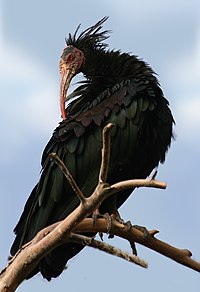
Photo from wikipedia
Abstract: Necropsy (n = 144) and medical (n = 121) records of captive northern bald ibis (NBI; Geronticus eremita), African sacred ibis (ASI; Threskiornis aethiopicus), and scarlet ibis (SCI; Eudocimus… Click to show full abstract
Abstract: Necropsy (n = 144) and medical (n = 121) records of captive northern bald ibis (NBI; Geronticus eremita), African sacred ibis (ASI; Threskiornis aethiopicus), and scarlet ibis (SCI; Eudocimus ruber) housed at the Zoological Society of London's London Zoo (LZ) from 2000 to 2020 were reviewed. Pododermatitis was a common cause of morbidity in all species (79 cases in 247 examinations). Trauma (58 of 144), the majority being caused by suspected collisions with stationary objects in the zoo's habitats, infectious diseases (32 of 144), predominantly valvular endocarditis (10 of 32), and aspergillosis (9 of 32) were major causes of mortality. The odds of a morbidity being related to toxicosis were 4.4 times greater in NBI than for ASI (95% CI, 1.5–13.3; P < 0.05); all cases in the NBI were plumbism. Overall, females of all species had 3.4 times greater odds of undetermined morbidity than males (95% CI, 1.5–7.9; P < 0.05), and the majority (16 of 25) were birds that were thin without an apparent cause. Nestlings had 11.3 times greater odds of nutritional morbidity than adults (95% CI, 1.7–73.0) and 5.5 times greater than juveniles (95% CI, 0.7–41.0; P < 0.05). These data have identified areas that require further study in the population of NBI, ASI, and SCI held at LZ.
Journal Title: Journal of Zoo and Wildlife Medicine
Year Published: 2023
Link to full text (if available)
Share on Social Media: Sign Up to like & get
recommendations!